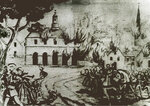



Imagine, if only you will, that you have attended Sunday morning worship services on May 29, 1831, only to leave the sanctuary to see downtown ablaze.
A date, you can be sure, that lives in city infamy.
It was a fire that ravaged downtown Fayetteville, including 600 buildings to include what history tells us were 105 stores, two banks, two hotels, a school, all but one of the city’s churches and countless homes.
“What makes this fire so pivotal in our community’s history is not only the scale but the lack of loss of life,” says Heidi Bleazey, manager of historic and natural resources with the Fayetteville History Museum. “No one perished directly in the fire. But the volume of publicity this made nationally and internationally and the overwhelming response of rebuilding support from communities across the state and nation to help rebuild our city. It really shows how significant our community was as a travel and trade center.”
The fire, city history tells us, was an inferno that ignited in the kitchen of James Kyle’s house near Market Square. It took four hours to contain it, and structures were burned and charred like nothing townsfolk had ever seen.
“The fire jumped from wooden roof to wooden roof, and the light pine buildings were like tinder as the flames raced from the center of town,” author Scott A. Miskimon would write in his “North Carolina’s Fiery Test,” which was published on May 29, 2006, in The News & Observer newspaper and updated in July of 2010. "… As the fire swept north on Green Street, it crossed the creek, consumed a new bridge and then devoured the Episcopal church. The fire moved east on Person Street, and Pastor (Henry) Rowland watched in horror as it hit his church.”
Miskimon would write with detailed description about the flames engulfing First Presbyterian Church.
“The tall steeple of the Presbyterian church seemed a pyramid of fire,” Miskimon wrote. “For a while, it stood firm. Soon the bell descended with a crash — the steeple trembled, tottered and fell.”
The nearby Catholic chapel next would go up in flames, history tells us.
Even the city fire engine, according to historic reports, succumbed to the blaze.
Traumatized by the fire, Miskimon wrote, residents later gathered on the outskirts of the city and slept the first of many nights there.
And other downtown fires
Bleazey will be telling you all about the Great Fire of 1831 at 1 p.m. Saturday at the State and Local History Room of the Cumberland County Headquarters Library on Maiden Lane.
“The program will last about an hour to an hour and a half,” Bleazey says.
You’ll learn that the fire destroyed the old State House, too, and how the city rebuilt downtown from ruins with the help of $100,000 in private donations from near and far.
You’ll learn not only about the Great Fire of 1831 but about other city fires as well.
“One of the earliest documented happened in 1792 at a tavern on Green Street,” Bleazey says. “So much of our early history is tavern-related. A fire in June of 1845 that took out 55 buildings in the Hay and Gillespie streets vicinity.”
And other fires, Bleazey says, in 1892 and 1906.
“I also will discuss some other random clippings of fires,” Bleazey says, “and how the city worked in its early days to address fire prevention.”
Epilogue
Weeks Parker is a city historian and published “Fayetteville, North Carolina: A Pictorial History” in 1984 that included accounts of the Great Fire of 1831.
“On a Sunday afternoon on May 29, 1831, at 12 noon, James Kyle, who lived on the northwest corner of Market Square in downtown Fayetteville, was cooking his Sunday meal on his stove when he accidentally allowed the fire to get out of control,” Parker would write in his book. “This fire quickly spread from his kitchen to other houses on Hay Street, Maiden Lane, Person Street, Gillespie Street, Anderson Street, Old Street, Bow Street and Green Street.”
All the downtown churches in the area were destroyed, he says, except for the walls of First Presbyterian Church on Ann Street.
“After the fire, Mr. Kyle built a new home at 234 Green St. on the former Fayetteville Academy site,” Parker wrote in his book. “An Italianate/Greek Revival structure became a part of the residential elegance on Green Street and in the 1960s was converted by the city of Fayetteville to offices for the mayor of the city, city manager and city attorney.”
Parker offers a final word on the inferno that stunned city residents nearly 200 years ago.
“The Great Fire of 1831 was the most devastating of all fires in Fayetteville's history,” Parker says. “With money and food donated by citizens of Baltimore and Boston, most of the demolished buildings in downtown Fayetteville were eventually restored. The fires of 1792, 1845, 1892, and 1906 were minor when compared to the Fire of 1831.”
Bill Kirby Jr. can be reached at billkirby49@gmail.com or 910-624-1961.